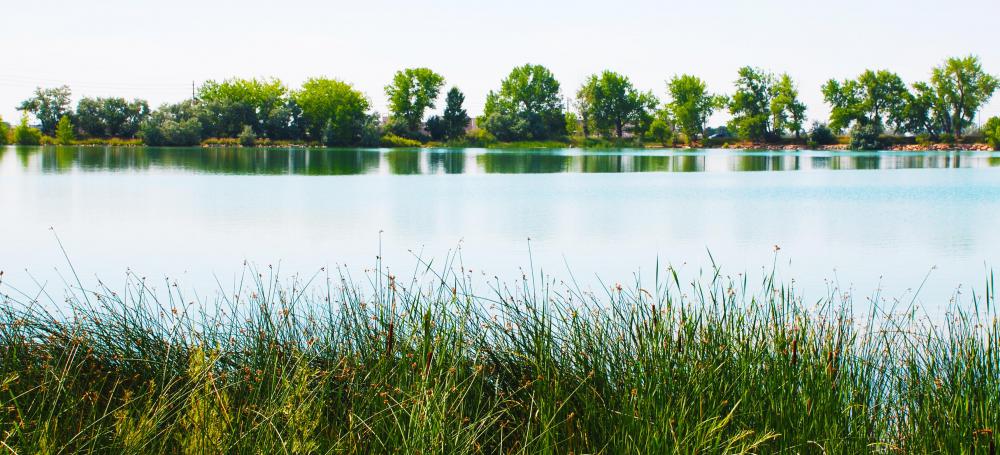At AllThingsNature, we're committed to delivering accurate, trustworthy information. Our expert-authored content is rigorously fact-checked and sourced from credible authorities. Discover how we uphold the highest standards in providing you with reliable knowledge.
What Is an Artificial Wetland?
An artificial wetland is a man-made approximation of a natural wetland habitat. These constructed wetlands are frequently employed as part of programs designed to restore natural wetland habitats and ecosystems. Additionally some artificial wetlands are further engineered so as to serve other purposes, often related to water or sewage filtration and treatment. Such engineered wetlands can often be a viable alternative to more industrial processes of water and waste treatment.
Humans have tended to eliminate wetlands as part of the process of development, a trend that extends back into antiquity. Wetlands are areas where the soil is naturally wet nearly all the time and where surface water is very common. The agricultural revolution in Europe saw a great decrease in the overall acreage of wetlands, as swamps, bogs, and fens were drained and turned into farmland. Similar practices have been widely employed in other regions in more recent years, to the detriment of the environment, and with unforeseen negative consequences for human populations.

Natural wetlands serve a variety of biological functions. They provide habitat for a diverse array of plant and animal species. These ecological niches have been at risk of disappearing entirely for decades. An artificial wetland is designed to mimic many of the characteristics of a natural wetland, and provides a home to many of the same species.

Recent research has shown that wetlands play an important role in ameliorating some types of environmental conditions. Wetlands naturally absorb and hold excess water that might otherwise lead to flooding. Coastal wetlands have been shown to play a crucial role in mitigating the impact of large storms. An artificial wetland can serve these functions in areas where the natural wetland has been reduced in size or eliminated.
An additional property of an artificial wetland is its ability to serve as a giant chemical reactor and filter. Through the careful selection of soils, gravels, and plant species, environmental engineers can tailor an artificial wetland to perform certain useful tasks. In areas where a great deal of fertilizer is used, for example, it can contaminate groundwater supplies. A carefully-planned artificial wetland can be constructed in such a fashion as to remove excess fertilizer from the water supply before it ever reaches a water treatment plant.
Water and sewage treatment plants themselves can be designed as artificial wetlands. Properly-constructed cascades of wetland plants and soils can serve as extremely efficient filtration systems. This type of artificial wetland has a positive impact on the environment both by supplying habitat and by minimizing pollution through non-industrial means.
Frequently Asked Questions
What is an artificial wetland and how does it differ from a natural wetland?
An artificial wetland, also known as a constructed or man-made wetland, is a water system created by humans to replicate the functions of a natural wetland. Unlike natural wetlands that form through ecological processes over time, artificial wetlands are designed and built to address specific issues such as wastewater treatment, flood control, and habitat restoration. They often incorporate native plants and engineered soils to mimic natural conditions.
Why are artificial wetlands created?
Artificial wetlands are created for several purposes, including improving water quality by filtering pollutants, providing habitat for wildlife, mitigating flood risks, and restoring ecosystems that have been lost to development. According to the Environmental Protection Agency, constructed wetlands can remove up to 60% of metals in the water and reduce nitrogen content by up to 80%, making them effective for wastewater treatment.
How effective are artificial wetlands in treating wastewater?
Artificial wetlands are highly effective in treating wastewater, as they utilize natural processes involving wetland vegetation, soils, and their associated microbial assemblages to improve water quality. Studies have shown that they can significantly reduce concentrations of nutrients, pathogens, and heavy metals from municipal and industrial wastewater, sometimes achieving removal rates comparable to traditional treatment systems.
Can artificial wetlands support biodiversity?
Yes, artificial wetlands can support a diverse range of flora and fauna. By providing a variety of aquatic habitats, they can become home to numerous species of birds, fish, amphibians, and invertebrates. The success in biodiversity support depends on the design and management of the wetland, aiming to mimic natural conditions as closely as possible to encourage colonization by local species.
What are the maintenance requirements for an artificial wetland?
Maintenance for artificial wetlands typically involves managing vegetation, ensuring proper water flow, and monitoring water quality. Regular inspections are necessary to detect and address issues such as invasive species, sediment accumulation, or changes in hydrology. Properly designed and maintained artificial wetlands can be self-sustaining with minimal intervention after initial establishment.
How do artificial wetlands contribute to climate change mitigation?
Artificial wetlands contribute to climate change mitigation by sequestering carbon dioxide, a major greenhouse gas. Wetland plants absorb CO2 during photosynthesis and store carbon in their biomass and soil. According to research, wetlands are among the most effective ecosystems for carbon sequestration, potentially storing three to five times more carbon per equivalent area than tropical forests.
AS FEATURED ON:
AS FEATURED ON:












Discuss this Article
Post your comments